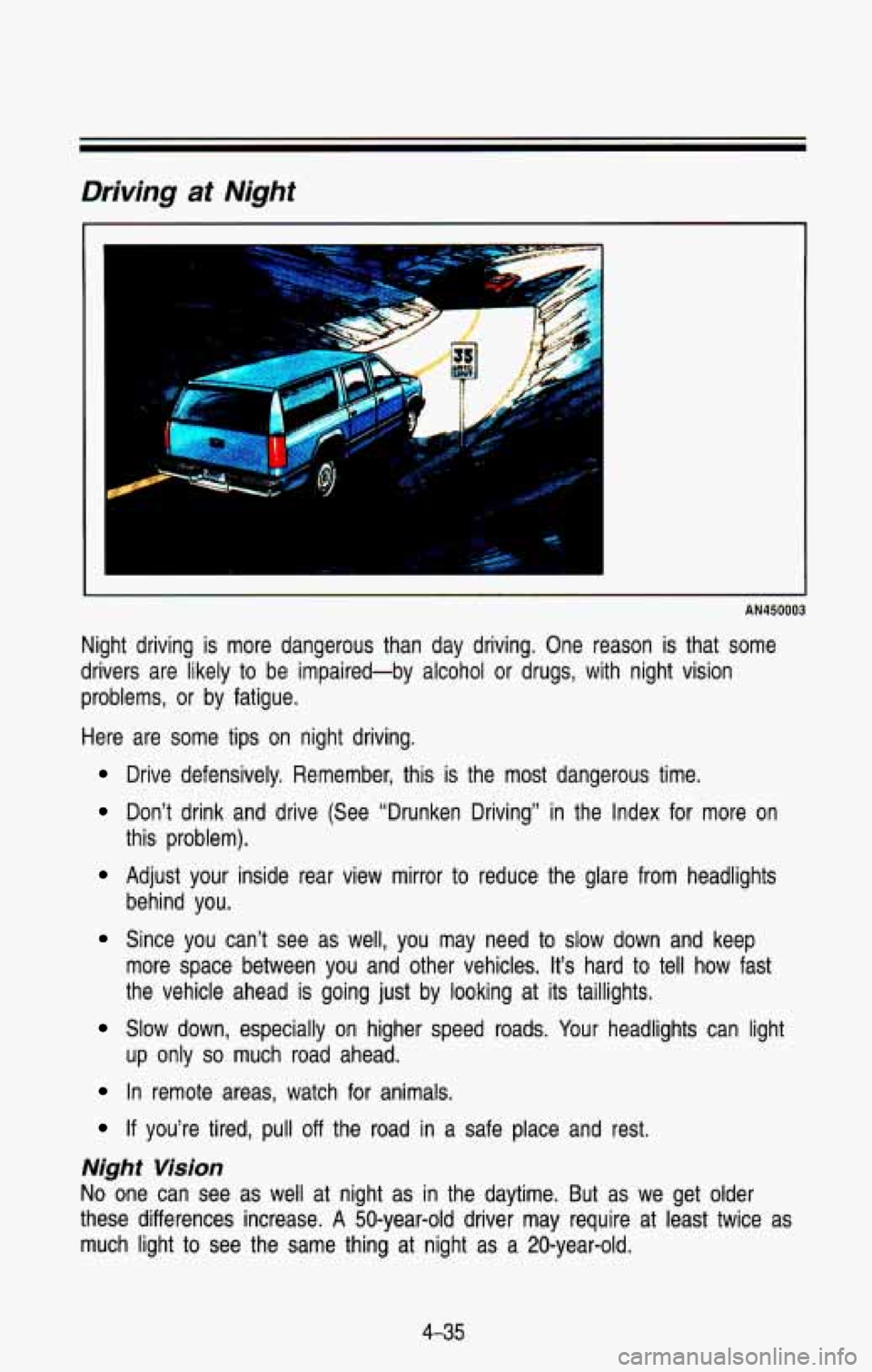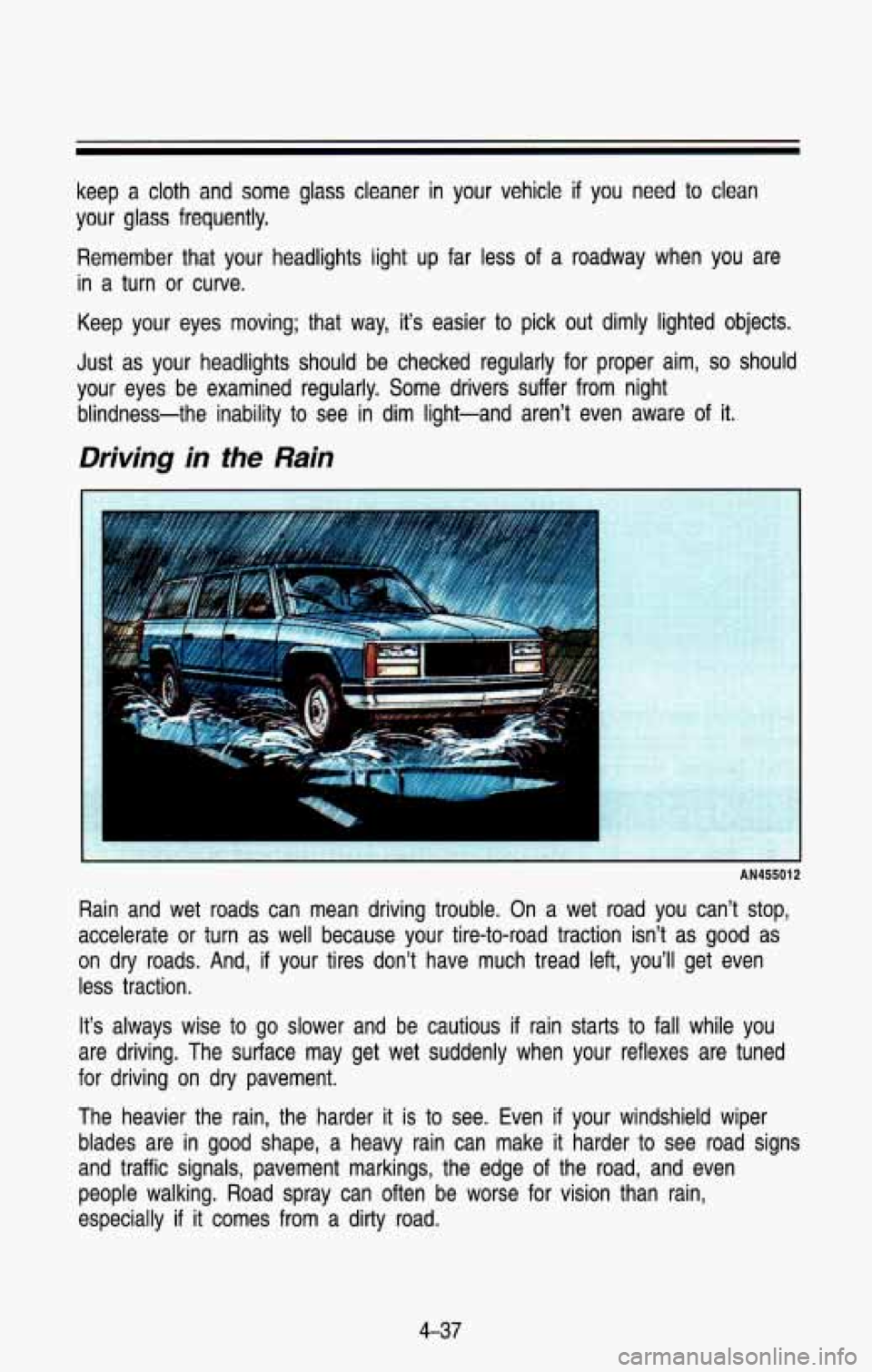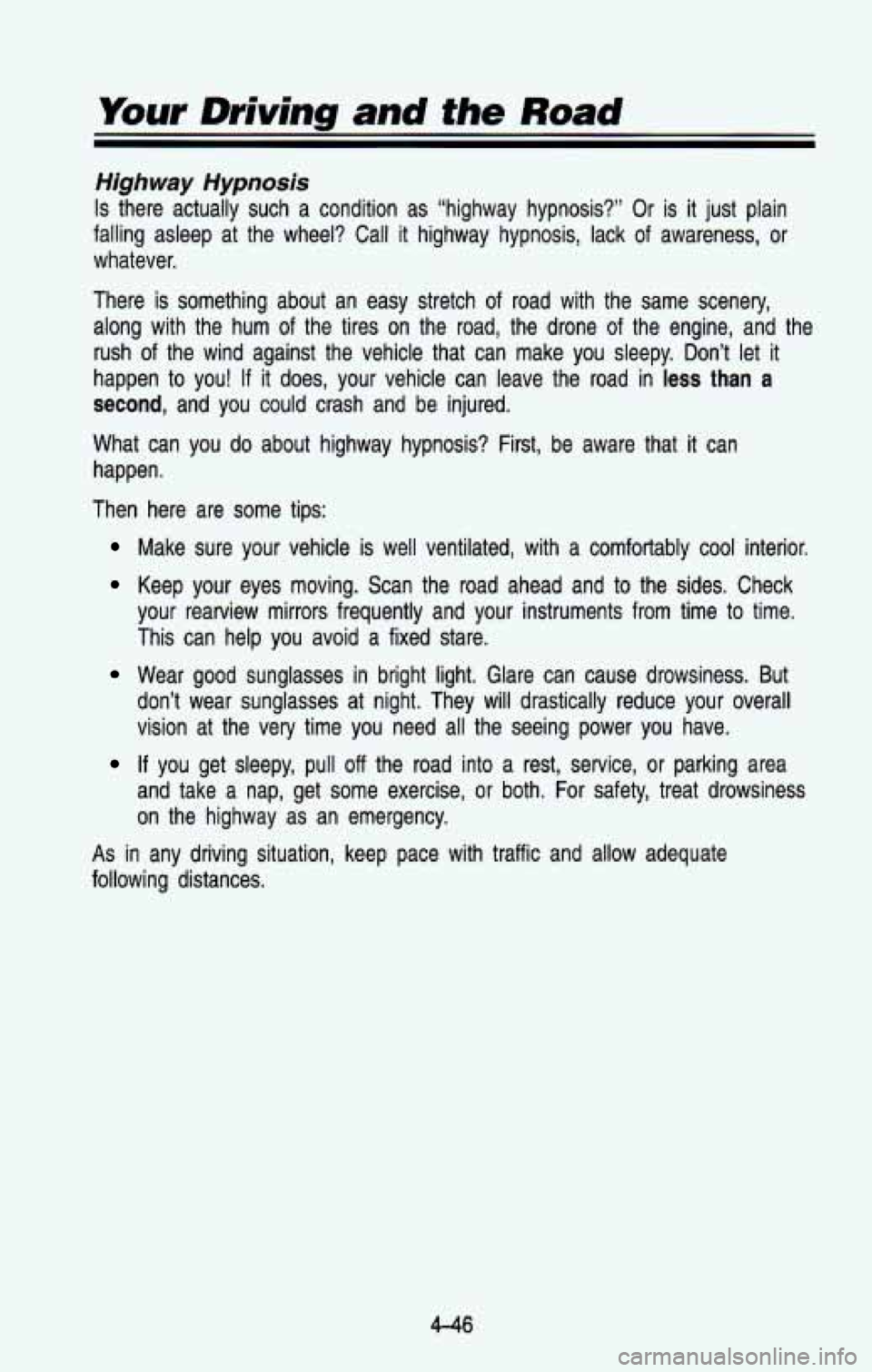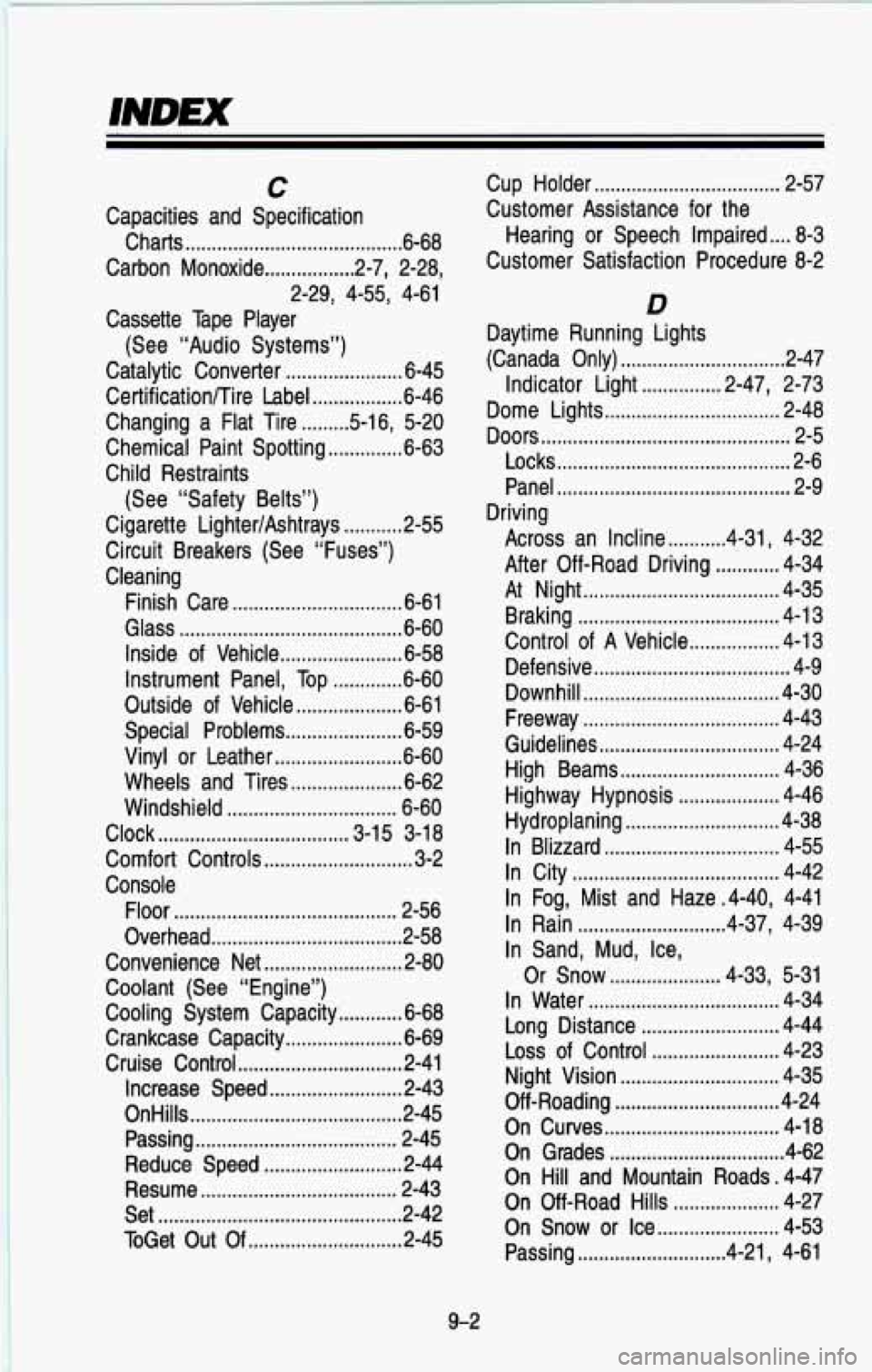1993 CHEVROLET BLAZER night vision
[x] Cancel search: night visionPage 202 of 386

Driving at Night
me--===
AN450003
Night driving is more dangerous than day driving. One reason is that some
drivers are likely to be impaired-by alcohol
or drugs, with night vision
problems, or by fatigue.
Here are some tips on night driving.
Drive defensively. Remember, this is the most dangerous time.
Don’t drink and drive (See “Drunken Driving” in the Index for more on
this problem).
Adjust your inside rear view mirror to reduce the glare from \
headlights
behind you.
Since you can’t see as well, you may need to slow down and keep
more space between you and other vehicles. It’s hard to tell how fast
the vehicle ahead is going just by looking at its taillights.
Slow down, especially on higher speed roads. Your headlights can light
In remote areas, watch for animals.
up only
so much road ahead.
If you’re tired,
pull off the road in a safe place and rest.
Night Vision
No one can see as well at night as in the daytime. But as we get older
these differences increase.
A 50-year-old driver may require at least twice as
much light
to see the same thing at night as a 20-year-old.
4-35
Page 203 of 386

Your Driving and the Road
What you do in the daytime can also affect your night vision. For example, if
you spend the day in bright sunshine you are wise to wear sunglasses. Your
eyes will have less trouble adjusting to night.
But
if you’re driving, don’t wear sunglasses at night. They may \
cut down on
glare from headlights, but they also make a lot of things invisible that should
remain visible-such as parked cars, obstacles, pedestrians, or e\
ven trains
blocking railway crossings. You may want
to put on your sunglasses after you
have pulled into a brightly-lighted service or refreshment area. Eyes shielded
from that glare may adjust more quickly
to darkness back on the road. But
be sure
to remove your sunglasses before you leave the service area.
You can be temporarily blinded by approaching lights. It can take a second or
two, or even several seconds, for your eyes to readjust
to the dark. When
you are faced with severe glare (as from a driver who doesn’\
t lower the high beams, or a vehicle with misaimed headlights), slow down a li\
ttle. Avoid
staring directly into the approaching lights.
If there is a line of opposing
traffic, make occasional glances over the line of headlights
to make certain
that one
of the vehicles isn’t starting to move into your lane. Once you are
past the bright lights, give your eyes time to readjust before resuming speed.
High Beams
If the vehicle approaching you has its high beams on, signal by \
flicking yours
to high and then back to low beam. This is the usual signal to lower the
headlight beams. If the other driver still doesn’t lower the beams, resist the
temptation
to put your high beams on. This only makes two half-blinded
drivers.
On a freeway, use your high beams only in remote areas where you w\
on’t
impair approaching drivers. In some places, like cities, using \
high beams is
illegal.
When you follow another vehicle on a freeway or highway, use \
low beams.
True, most vehicles now have day-night mirrors that enable the \
driver to reduce glare. But outside mirrors are not
of this type and high beams from
behind can bother the driver ahead.
A Few More Night Driving Suggesiions
Keep your windshield and all the glass on your vehicle clean-inside and out.
Glare at night is made much worse by dirt
on the glass. Even the inside of
the glass can build up a film caused by dust. Tobacco smoke also makes
inside
glass surfaces very filmy and can be a vision hazard if it’s left there.
Dirty glass makes lights dazzle and flash more than clean glas\
s would,
making the pupils of your eyes contract repeatedly. You might even want
to
4-36
Page 204 of 386

keep a cloth and some glass cleaner in your vehicle if you need to clean
your glass frequently.
Remember that your headlights light up far less of a roadway when you are
in a turn or curve.
Keep your eyes moving; that way, it’s easier to pick out dimly lighted objects.
Just as your headlights should be checked regularly for proper \
aim,
so should
your eyes be examined regularly. Some drivers suffer from night\
blindness-the inability to see in dim light-and aren’t even aware of it.
Driving in the Rain
AN455012
Rain and wet roads can mean driving trouble. On a wet road y\
ou can’t stop,
accelerate or turn as well because your tire-to-road traction isn’t as good as
on dry roads. And,
if your tires don’t have much tread left, you’ll get even
less traction.
It’s always wise to go slower and be cautious
if rain starts to fall while you
are driving. The surface may get wet suddenly when your reflex\
es are tuned
for driving on
dry pavement.
The heavier the rain, the harder it is to see. Even
if your windshield wiper
blades are in good shape, a heavy rain can make it harder to see road signs
and traffic signals, pavement markings, the edge of the road, and even
people walking. Road spray can often be worse for vision than rain,
especially
if it comes from a dirty road.
4-37
Page 213 of 386

Your Driving and the Road
Highway Hypnosis
Is there actually such a condition as “highway hypnosis?” Or \
is it just plain
falling asleep at the wheel? Call
it highway hypnosis, lack of awareness, or
whatever.
There is something about an easy stretch of road with the sam\
e scenery, along with the hum of the tires on the road, the drone of the engine, and the
rush
of the wind against the vehicle that can make you sleepy. Don’\
t let it
happen to you! If it does, your vehicle can leave the road in less than a
second,
and you could crash and be injured.
What can you do about highway hypnosis? First, be aware that
it can
happen.
Then here are some tips:
Make sure your vehicle is well ventilated, with a comfortably \
cool interior.
Keep your eyes moving. Scan the road ahead and to the sides. Check
your rearview mirrors frequently and your instruments from time \
to time.
This can help you avoid a fixed stare.
Wear good sunglasses in bright light. Glare can cause drowsiness. But
don’t wear sunglasses at night. They will drastically reduce your overall
vision at the very time you need all the seeing power you have.
If you get sleepy, pull off the road into a rest, service, or parking area
and take a nap, get some exercise, or both. For safety, treat\
drowsiness
on the highway as an emergency.
As in any driving situation, keep pace with traffic and allow ade\
quate
following distances.
4-46
Page 377 of 386

INDEX
C
Capacities and Specification Charts
......................................... 6-68
Carbon Monoxide
................. 2.7. 2.28.
Cassette Tape Player
Catalytic Converter
...................... 6-45
Certificationnire Label
................. 6-46
Changing a Flat Tire
......... 5.16. 5-20
Chemical Paint Spotting
.............. 6-63
Child Restraints 2.29. 4.55.
4-61
(See “Audio Systems”)
(See “Safety Belts”)
Cigarette LightedAshtrays
........... 2-55
Circuit Breakers (See “Fuses”)
Cleaning Finish Care
................................ 6-61
Glass
.......................................... 6.60
Inside of Vehicle
....................... 6-58
Instrument Panel. Top
............. 6-60
Outside of Vehicle
.................... 6-61
Special Problems
...................... 6-59
Vinyl
or Leather ........................ 6-60
Wheels and Tires
..................... 6-62
Windshield
................................ 6-60
Comfort Controls
............................ 3-2
Console
Floor
.......................................... 2-56
Overhead
.................................... 2.58
Convenience Net
.......................... 2-80
Coolant (See “Engine”)
Cooling System Capacity
............ 6-68
Crankcase Capacity
...................... 6-69
Cruise Control
............................... 2-41
Increase Speed
......................... 2-43
OnHills
........................................ 2-45
Clock
.................................... 3-15
3-18
Passing
...................................... 2-45
Reduce Speed
.......................... 2-44
Resume
..................................... 2-43
Set
.............................................. 2-42
ToGet Out Of
............................. 2-45 Cup Holder
................................... 2-57
Customer Assistance for the
Hearing
or Speech Impaired .... 8-3
Customer Satisfaction Procedure 8-2
D
(Canada Only) ............................... 2-47
Daytime Running Lights
Indicator Light
............... 2.47. 2-73
Dome Lights
................................. 2-48
Doors
............................................... 2-5
Panel
............................................ 2-9
Across an Incline
........... 4-31 . 4-32
After Off-Road Driving
............ 4-34
At Night ..................................... 4-35
Braking
...................................... 4-13
Control
of A Vehicle ................. 4-13
Defensive
..................................... 4-9
Downhill
..................................... 4-30
Freeway
..................................... 4-43
Guidelines
.................................. 4-24
High Beams
.............................. 4-36
Highway Hypnosis
................... 4-46
Hydroplaning
............................. 4-38
In Blizzard
................................. 4-55
In City
....................................... 4-42
In Fog. Mist and Haze .4.40. 4-41
In Rain
............................ 4.37. 4-39
In Sand. Mud. Ice.
Or Snow ..................... 4.33. 5-31
In Water
.................................... 4-34
Long Distance
.......................... 4-44
Loss of Control
........................ 4-23
Night Vision
.............................. 4-35
Off -Roading ............................... 4-24
On Curves
................................. 4-18
On Grades
................................. 4.62
On Hill and Mountain Roads
. 4-47
On Off-Road Hills
.................... 4-27
On Snow
or Ice ....................... 4-53
Passing
............................ 4-21 . 4-61
Locks
............................................ 2-6
Driving
9-2